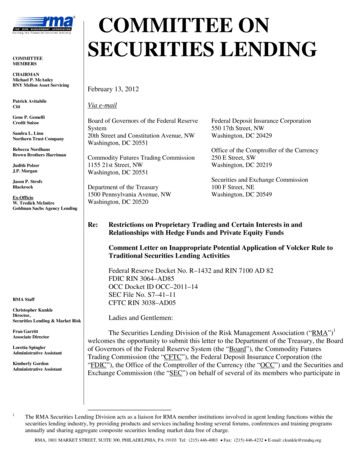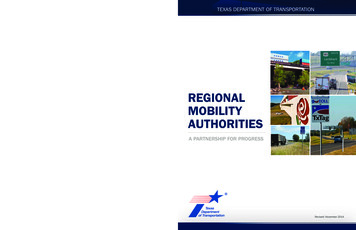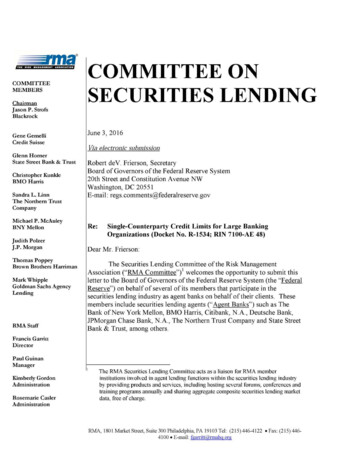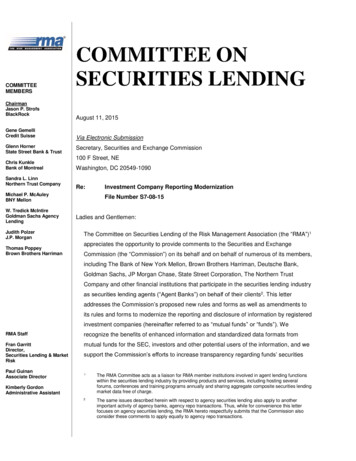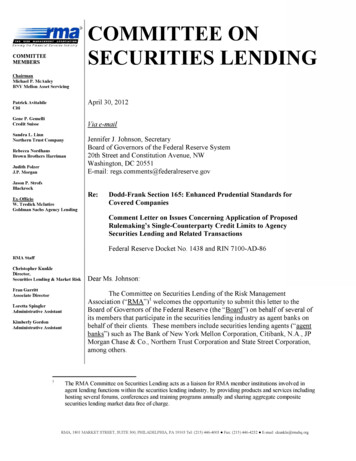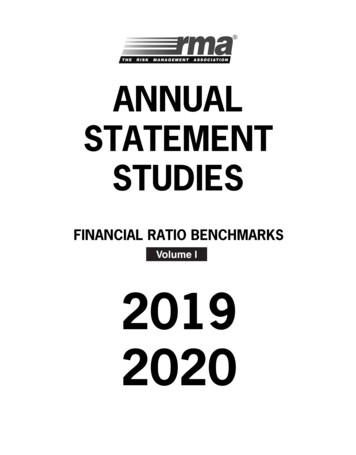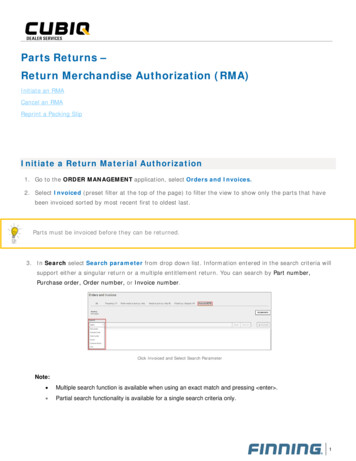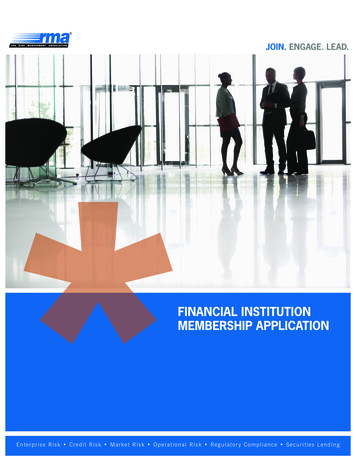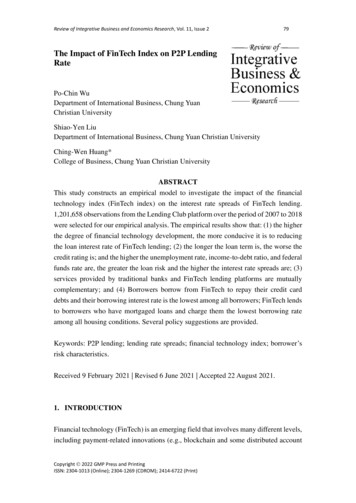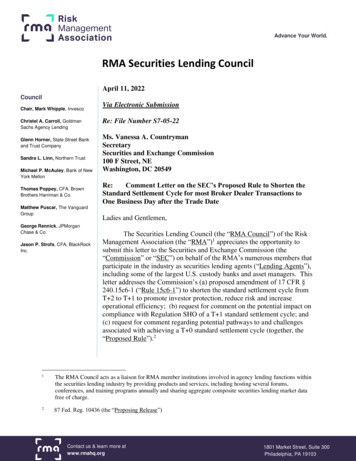
Transcription
Advance Your World.RMA Securities Lending CouncilApril 11, 2022CouncilChair, Mark Whipple, InvescoChristel A. Carroll, GoldmanSachs Agency LendingGlenn Horner, State Street Bankand Trust CompanySandra L. Linn, Northern TrustMichael P. McAuley, Bank of NewYork MellonThomas Poppey, CFA, BrownBrothers Harriman & Co.Matthew Puscar, The VanguardGroupGeorge Rennick, JPMorganChase & Co.Jason P. Strofs, CFA, BlackRockInc.Via Electronic SubmissionRe: File Number S7-05-22Ms. Vanessa A. CountrymanSecretarySecurities and Exchange Commission100 F Street, NEWashington, DC 20549Re:Comment Letter on the SEC’s Proposed Rule to Shorten theStandard Settlement Cycle for most Broker Dealer Transactions toOne Business Day after the Trade DateLadies and Gentlemen,The Securities Lending Council (the “RMA Council”) of the RiskManagement Association (the “RMA”)1 appreciates the opportunity tosubmit this letter to the Securities and Exchange Commission (the“Commission” or “SEC”) on behalf of the RMA’s numerous members thatparticipate in the industry as securities lending agents (“Lending Agents”),including some of the largest U.S. custody banks and asset managers. Thisletter addresses the Commission’s (a) proposed amendment of 17 CFR §240.15c6-1 (“Rule 15c6-1”) to shorten the standard settlement cycle fromT 2 to T 1 to promote investor protection, reduce risk and increaseoperational efficiency; (b) request for comment on the potential impact oncompliance with Regulation SHO of a T 1 standard settlement cycle; and(c) request for comment regarding potential pathways to and challengesassociated with achieving a T 0 standard settlement cycle (together, the“Proposed Rule”).21The RMA Council acts as a liaison for RMA member institutions involved in agency lending functions withinthe securities lending industry by providing products and services, including hosting several forums,conferences, and training programs annually and sharing aggregate composite securities lending market datafree of charge.287 Fed. Reg. 10436 (the “Proposing Release”)Contact us & learn more atwww.rmahq.org1801 Market Street, Suite 300Philadelphia, PA 19103
Advance Your World.General Considerations Related to Agency Securities LendingAgency securities lending is a well-established, safe and sound activity thatsupports global capital markets activities and facilitates trade settlement. By effectivelyincreasing the supply of securities available for these and other market activities, securitieslending improves market liquidity and enhances price discovery. 3 Securities lenders (“Lenders”)largely consist of buy-side entities such as public and private pension funds, mutual funds,ERISA plans, endowment funds of not-for-profit institutions, insurance companies, investmentfunds and other similar entities or funds into which such entities invest. Borrowers in securitieslending transactions largely consist of broker-dealers, banks and other financial institutions.Lending Agents act as intermediaries in securities lending programs byfacilitating loans on behalf of Lenders to qualified borrowers (“Borrowers”). Securities aregenerally lent pursuant to (i) securities lending authorization agreements between Lenders andLending Agents, and (ii) securities loan agreements (“SLA”) between Borrowers and LendingAgents (acting as agent for Lenders as principals). Under the SLAs, in exchange for the loan ofsecurities, Borrowers provide Lenders (generally, via their Lending Agents) with initial collateralworth more than the loaned securities, typically by 2% to 5%, depending upon the characteristicsof the loaned securities, the collateral and other factors. The loaned securities and collateral arethen marked-to-market daily to ensure that the collateral consistently meets the requisite value.The length of the standard settlement cycle becomes an issue in the context ofsecurities lending when a Lender sells a security that is on loan. At that time, the Lender mustnotify the Lending Agent of the sale so that the Lending Agent can either reallocate the loan toanother lender or recall the loaned securities from the Borrower for delivery to the Lender intime to settle the sale. When the Borrower receives a recall notice from the Lending Agent, itwill seek to source replacement securities to satisfy the delivery requirement. If the Borrower isunable to borrow the securities, it will be required to buy them in the market. All of this takestime, even in the most automated world, thus we ask that the SEC delay the effective date to late2024 at the earliest.3Lenders use agency securities lending services from Lending Agents in order to obtain additionalincremental revenues. Agency securities lending activities developed initially as an outgrowth of Lending Agents’custody and related activities, and have long been regulated, examined and treated by regulators as traditionalbanking services. See, e.g., Securities Lending, Federal Financial Institutions Examination Council, SupervisoryPolicy (1985) (addressing appropriate regulatory guidelines for the growing securities lending industry); Letter fromJ. Virgil Mattingly, General Counsel, Board, William F. Kroener, General Counsel, Federal Deposit InsuranceCorporation, and Julie L. Williams, General Counsel, Office of the Comptroller of the Currency (“OCC”), to theSecurities and Exchange Commission (Dec. 10, 2002) (indicating that interagency guidelines “ensure that banksconduct their securities lending activities in a safe and sound manner and consistent with sound business practices,investor protection considerations and applicable law”); Bank of England, Securities Lending and Repo Committee,Securities Borrowing and Lending Code of Guidance (July 2009) (describing how securities lending transactions areregulated both under UK regulations and EU directives), available /gilts/stockborrowing.pdf; Directive 2004/39/EC, of theEuropean Parliament and of the Council of 21 April 2004 on Markets in Financial Instruments, available o?uri OJ:L:2004:145:0001:0044:EN:PDF.Contact us & learn more atwww.rmahq.org1801 Market Street, Suite 300Philadelphia, PA 19103
Advance Your World.The SEC’s Proposal for a T 1 Standard Settlement CycleFor many of the reasons set forth in the Proposing Release, RMA generallysupports shortening the standard settlement cycle to T 1. Time to settlement determines asignificant portion of a market participant’s risk exposure to a given securities transaction,including the time by which it can access its sale proceeds. Accelerating the time to settlementwill reduce credit, market, and liquidity risk. It will also serve to decrease the total number andmarket value of unsettled trades outstanding at any point in time, which should correspond with areduction in the market participant’s overall exposure to risk related to unsettled transactions. Wefurther agree that acceleration of the standard settlement cycle to T 1 could increase theefficiency of capital market transactions and reduce systemic risk.Along with the September 2017 implementation of the T 2 standard settlementcycle, the Commission asked market participants to continue to identify challenges toimplementation of a T 1 settlement cycle. Progress has been made in identifying thetechnological and operational changes that such an acceleration of timing would require ofmarket participants.Not to minimize the potential benefits referenced above, in the DTCC WhitePaper referenced in the Proposing Release, DTCC stated that while accelerating the standardsettlement cycle beyond T 2 may bring significant benefits to market participants, it alsorequires “careful consideration and a balanced approach so that settlement can be achieved asclose to the trade as possible without creating capital inefficiencies or introducing new,unintended consequences— such as inadvertently reducing or eliminating the benefits and costsavings provided by multilateral netting.4”Allocation and confirmation of institutional trades, trade documentation, globalsettlement and FX markets, corporate actions, prime brokerage services, settlement errors andfails, creation and redemption of ETFs, equity and debt offerings and regulatory requirements allfactor into this careful, balanced approach generally and specifically, with respect to thesecurities lending market.Shortening the standard settlement cycle to T 1 may increase the need for somemarket participants that engage in cross-border and cross-asset transactions to hedge risks thatmight arise from mismatched settlement cycles (T 1 in the U.S. and T 2 in Europe, forexample). Additionally, because the FX market has a T 2 settlement cycle, those marketparticipants may also be faced with a choice between bearing an additional day of currency riskdue to the need to sell Euros as part of the transaction and using the forward or futures markets tohedge away this risk. In each of these examples, the mismatch in settlement cycles among thevarious jurisdictions results in additional costs to market participants.DTCC, Advancing Together: Leading the Industry to Accelerated Settlement, at 2 (Feb. 2021) (“DTCC WhitePaper”), https://www.dtcc.com/- ettle-WP-2021.pdf.4Contact us & learn more atwww.rmahq.org1801 Market Street, Suite 300Philadelphia, PA 19103
Advance Your World.T 1 Impact to Timely Return of Securities on LoanAs far as operations and settlement errors are concerned, RMA agrees with theCommission that though a move to a shorter settlement cycle would likely bring with it a furtherincentive to automate processing, it may also exacerbate remaining operational risk, becausemarket participants would have less time to resolve errors, particularly on the return leg ofsecurities lending transactions. For example, if there is any error (i.e., incorrect quantity,settlement date or settlement instructions) in processing the return leg of a securities loan,including the sale details between the investment manager and the purchaser of the securities onloan, under a T 1 settlement environment, the parties would have one less day to resolve theerror. Under these circumstances, a shorter settlement cycle may increase the probability that theerror ultimately results in a settlement fail.Whether the various participants in the securities lending market, includinginvestment managers, custodians, Lending Agents and Borrowers, are able to efficiently processand communicate executed sale transactions of securities on loan will impact the success of anaccelerated standard settlement cycle. Lending Agents depend on receiving prompt notificationsfrom investment managers or custodians of executed sales of securities on loan. Upon receipt ofthat notice, Lending Agents determine whether they have sufficient supply of the security in theirinventory or if they need to recall the security from a Borrower. If the latter, Lending Agentswill seek to recall the loaned securities underlying the sale transaction as promptly as possible, inthe best case early on the trade date of the sale transaction to minimize the risk of settlementfailure on settlement date. To make this process as seamless as possible and to facilitate anaccelerated T 1 standard settlement cycle, in addition to receipt of timely communication of thesale transaction, Lending Agents will need to employ automated processes for determiningwhether a recall is required. Recall notices will also need to be provided to Borrowers promptly,on an automated basis. These automated processes would likely involve enhancements throughupgrades developed by vendors, such as Pirum, Loanet and EquiLend. And Borrowers will needto be able to electronically accept recalls and integrate them into their systems in time for theovernight, inventory calculation batch processing to put all parties in the best position for theBorrowers to source the securities and return them on the settlement date to prevent settlementfailures.Though RMA is supportive of moving to a T 1 standard settlement cycle, wewant to highlight that, if implemented today, the technology and processes used by securitieslending market participants would not be ready to successfully implement this new standard. Atarget of late 2024 is more realistic but will still be challenging given other competing demandsfor resources such as Proposed Rule 10c-1, should that be finalized and implemented.The Impact of T 1 or T 0 on Regulation SHOUnder 17 CFR 242.200(g) (“Rule 200(g)”), a broker-dealer is required to mark allsell orders of any equity security as “long,” “short,” or “short exempt.” Rule 200(g)(1) permits abroker-dealer to only mark a sale as “long” if the seller is “deemed to own” the security beingsold under 17 CFR 242.200 (a) through (f) and the security either (i) is in the broker-dealer’sContact us & learn more atwww.rmahq.org1801 Market Street, Suite 300Philadelphia, PA 19103
Advance Your World.physical possession or control; or (ii) is reasonably expected to be in the broker-dealer’spossession or control by the settlement date of the security.When the standard settlement cycle was T 3, the Commission advised that if abeneficial owner of a security that was on loan, was to sell that security and a bona fide recallwas given within 2 business days after the trade date of the sale, then that beneficial ownerwould be “deemed to own” the security for purposes of Rule 200(g)(1), and the sale would notbe treated as “short” for purposes of Rule 204. The Commission also stated that a broker-dealermay mark such orders as “long” sales if such marking also complies with Rule 200(c) ofRegulation SHO, and the closeout requirements of Rule 204. In the case of a T 2 settlementcycle, Rule 204 would require delivery of the loaned securities into the sale by T 4 (T 2 plus a 2day settlement cycle) in time to close out any fails on sales marked “long” by the beginning oftrading on T 5. In a T 1 environment, such delivery period would be T 3 (T 1 plus a 2 daysettlement cycle) to enable the broker-dealer to close out any fails on sales marked “long” bythe beginning of trading on T 4.5RMA agrees that if the standard settlement cycle is shortened to T 1, therequirements under Rule 200(g) may result in a change in the timing by which a broker-dealerwould need to initiate a bona fide recall of a loaned security to mark the sale of such loaned, butrecalled, security “long” for purposes of Rule 200(g)(1). We understand that some brokerdealers may have shortened the previous 3 business day recall period to 2 business days underthe T 2 standard settlement cycle to ensure they are able to settle on the proper settlement date.If T 1 is imposed, the recall period would be even shorter (and broker-dealers could choose tofurther shorten it to one business day) – which may limit securities lending participants’ abilityto comply with these rules.Should the implementation of T 1 result in any changes to Reg SHO, RMArecommends that the SEC guidance regarding classification of the sale of a security that is onloan as “long” remain unchanged.The Effects of Shortening the Settlement Cycle to T 0 on Securities Lending.RMA appreciates the SEC’s thoughtful analysis of the challenges that it hasidentified as impediments to implementing a T 0 standard settlement cycle and its interest infinding ways to overcome those challenges to improve settlement efficiencies and reduce risks.Moving to a T 0 standard settlement cycle would raise significant challenges; challenges that arefar more momentous than those the industry confronted by the move to a T 2 settlementenvironment or may confront in the move to a T 1 settlement environment. Processes such astrade reconciliations and exception management, and transactions with foreign counterparties(especially where time zones are least aligned) would need to be considered and revised.Payment systems used for final settlement would also require significant modification to enabletransactions late in the day, past the close of business. And then, there is the not insignificantissue related to the intraday timing mismatch between the receipt of cash and the receipt ofsecurities, which though present even today would likely be exacerbated by this change.5See Proposing Release, at 99.Contact us & learn more atwww.rmahq.org1801 Market Street, Suite 300Philadelphia, PA 19103
Advance Your World.Currently available market infrastructure does not support a T 0 environment; the technologyneeded to upgrade the market infrastructure to provide such support does not exist today.Set forth below are several of the questions the Commission has asked in PartIV.B.6 of the Proposing Release related to the challenges that might be faced by securitieslending market participants in implementing T 0 and RMA’s responses.113. To what extent would shortening the standard settlement cycle to T 0make it difficult for securities lenders to timely recall securities on loan?To facilitate a T 0 standard settlement cycle and put all agency securities lending models(custody, third party and in-house lending) on the same footing would require the developmentand implementation of an infrastructure for real time communication between investmentmanagers and all service providers, including, among others, custodians, fund accountants, andtransfer agents. In addition, agency securities lending would benefit from ensuring that LendingAgents receive data on a par with other market participants so that they are able to providebroker-dealers with same day communication and settlement of recalls.If a T 0 standard settlement cycle refers to instantaneous settlement, rather than same-daysettlement, then Lenders would be required to provide third party Lending Agents and third-partyadvisers with prenotifications of their intent to sell securities that are on loan. Portfoliomanagers would likely be uncomfortable with providing this information outside of their 4 wallsdue to the concern that the information could be shared. As a result, it is possible that theavailability of any given security would be restricted, reducing liquidity in the market, reducingprice discovery and leading to wide fluctuations when there are large tradesIf there were to be various settlement cycles for T 0, then the ability of Lending Agents totimely recall securities on loan would depend on the efficiency of the trade allocations andnotifications by Lenders to the Lending Agents.115. Please describe any technology changes that might be necessary to supportsecurities lending operations of market participants if the settlement cycle were shortened toT 0. Please include in any comments descriptions of existing technologies that may help theCommission identify and understand the limitations, if any, of such technologies with respectto a T 0 settlement cycle.RMA agrees with the SEC that if the settlement cycle was to be further accelerated to T 0,significant, expensive technological and operational changes would be required, including there-engineering of securities processing, the overall modernization of the current-day clearanceand settlement infrastructure, business model changes, revisions to industry-wide regulatoryframeworks, and the potential implementation of real-time currency movements.In addition, substantial improvement of current recall and return communication automation forLenders and Borrowers facilitated by vendors would be required. Given that under such tighttime frames there would likely be little appetite for bilateral recall processing, securities lendingoperations would require an increased adoption of automated solutions.Contact us & learn more atwww.rmahq.org1801 Market Street, Suite 300Philadelphia, PA 19103
Advance Your World.Lending Agents would need to be able to obtain, analyze, action, and transmit recall notices inreal time, or even in advance of T 0. This would require significant investment by LendingAgents and Lenders. The framework for this improved infrastructure does not exist today; itwould need to be completely re-designed not only based on each Lending Agent’s systems butalso based on necessary wider market infrastructure requirements.116. With respect to stock loan recalls, are there ways to improve the level ofcoordination between investment managers and third-party lending agents for underlyingfunds, and to facilitate partial stock loan recalls from bulk lending positions aggregated frommultiple institutional investors?Whether a Lending Agent needs to issue a recall upon receipt of notice of a Lender’s sale ofsecurities on loan is based on whether the Lending Agent has inventory in the particularsecurity. If the Lending Agent is able to reallocate the loan to another client, then the LendingAgent would not need to issue a recall. Partial stock recalls from bulk positions are no differentfrom fully recalled positions. As noted in previous responses, how Lenders execute, allocate, andcommunicate sales of loaned securities to their Lending Agents is the biggest determinant of howquickly the Lending Agent can recall the security from the Borrower.In a T 0 environment, wider adoption of standard processes and automated communicationmethods currently available would be needed by Borrowers, Lending Agents and investmentmanagers. Though incremental improvement of current infrastructure may be sufficient tosupport a T 1 environment, it would not be sufficient to support T 0. As stated above, thenecessary revisions to infrastructure to facilitate a T 0 environment do not even yet exist.117. To what extent might securities lenders need to rely on predictive analyticsto make decisions regarding which securities to recall before lenders can be sure such recallswill be necessary? What additional costs, if any, might be associated with the increased use ofpredictive analytics?RMA believes that predictive analytics to determine when a Lender will sell is not appropriateand should not be developed. An asset owner should be very concerned if any third party couldpredict whatever internal methodologies are used to execute sales. These methodologies areproprietary and reverse engineering them to predict when a Lender is going to sell would be abreach of trust by a Lending Agent.118. How might shortening the standard settlement cycle to T 0 impact marketparticipants seeking to borrow securities in the U.S. markets? Please include discussionregarding the possible impact on market participants’ ability to borrow securities that might bedifficult to borrow.Investment managers who view securities lending as important to their investment process willlikely allocate resources to facilitate lending in a T 0 environment. This may result indifferences in lending across managers. The securities lending industry would need to see theupstream improvements to the communication process to assess the impact to Lender andBorrower behaviour.Contact us & learn more atwww.rmahq.org1801 Market Street, Suite 300Philadelphia, PA 19103
Advance Your World.As previously noted, some Lenders might restrict a larger portion of their securities from beingavailable to loan to ensure that they would have sufficient supply in the event they needed tosell. Any such restriction would likely harm liquidity, making more securities harder to borrowand resulting in less market discovery and longer fail periods for less liquid securities.120. What impact, if any, would shortening the standard settlement cycle to T 0have on the cost of borrowing securities in the U.S.?As noted above, shortening the standard settlement cycle to T 0 would result in an increase inthe cost to borrow securities in the U.S. as there would be significant infrastructure costs toprepare for such a change. It would not be unexpected for those costs to be shared among marketparticipants, which could cause Lenders to re-think their participation in the purely voluntarysecurities lending market. Less Lender participation would result in less market liquidity,driving more securities into the “special” or “hard to borrow” categories.122. To what extent might shortening the standard settlement cycle to T 0reduce revenue securities lenders generate from loaning securities compared with a T 2 orT 1 settlement cycle?If a T 0 standard settlement cycle was to be implemented without material changes to theexisting communications, technological and operational infrastructures (which changes are notyet available or even in existence today), Lenders would need to be more conservative andimplement additional restrictions and limits, resulting in a reduction in the supply of lendablesecurities, higher costs and lower revenue.123. What impact, if any, might a T 0 settlement cycle have on overall liquidityin the U.S. markets if such a move were to reduce securities lending activity?As noted above, implementation of a T 0 standard settlement cycle, without the necessaryinfrastructure changes may cause an increased risk of settlement failure from participation insecurities lending which could have a chilling effect on participation, and, by extension, onliquidity. These factors could drive more securities into the “special” or “hard to borrow”categories.ConclusionWe appreciate the opportunity to provide these comments and would be happy toengage in a more comprehensive dialogue with the SEC. We agree that shortening the standardsettlement cycle to T 1, though challenging in and of itself, will promote investor protection,reduce risk and increase operational efficiency. However, market participants will need to investin technology enhancements and process changes to avoid an increase in trades failing due tobeing on loan. Therefore, we urge the SEC to delay the effective date to late 2024 at the earliest.Without such a delay, Lenders may add restrictions or limits to their securities lending programsto avoid trade settlement fails. This in turn would reduce liquidity and lead to further tradesettlement failures.Contact us & learn more atwww.rmahq.org1801 Market Street, Suite 300Philadelphia, PA 19103
Advance Your World.If desired by the SEC, the RMA Council would be pleased to meet with the SEC or itsstaff to assist the SEC in the development of any of the recommendations discussed in this letter.Sincerely,Fran GarrittMark WhippleDirectorSecurities Lending & Market RiskRisk Management AssociationChairmanCommittee on Securities LendingRisk Management AssociationContact us & learn more atwww.rmahq.org1801 Market Street, Suite 300Philadelphia, PA 19103
1 The RMA Council acts as a liaison for RMA member institutions involved in agency lending functions within the securities lending industry by providing products and services, including hosting several forums, conferences, and training programs annually and sharing aggregate composite securities lending market data free of charge.
